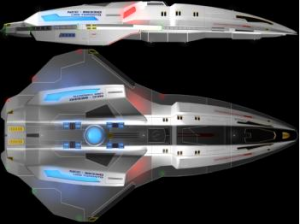Marine Combat Dropship
Contents
Class History
Originally designed as part of the Type-1 Runabout programme, Modular Runabout that eventually became the Marine Combat Dropship first flew circa 2403. Trials displayed the Runabout's speed, agility and ruggedness but also highlighted the limitations of the sensor systems, forcing Star Fleet to choose a different design. The Star Fleet Marine Corps immediately chose the vessel to replace their ageing Dropships, and began field testing the different modules.
After initial teething issues the final design was approved late in 2403 and production began. Designed almost as a small Starship in its own right, the Marine Combat Dropship has a powerful reactor core for a vessel its size, and thanks to the inclusion of bunk rooms and a sonic shower for the crew, can operate on its own for reasonably extensive missions without resupply or the support of a parent Starship - allowing the Marine Corps to operate its own patrol craft without diverting squadrons of fighters. The cargo module aft of the cockpit is not, like the older Danube-class, a series of modules, but rather a complete bay that can be swapped out or equipped as required specifically for a particular mission. This modular nature of the vessel endeared Marine Corps crews, and attracted the attention of Special Operations who acquired an undisclosed amount for their own needs.
Outside of combat roles, some Dropships have been put into service as General Officer transports, freeing up Marine Cruisers from this duty while still providing fast and comfortable transport for the officers. Since 2404, the Marine Combat Dropship has served at the front line of any major conflict, and though losses have been high as they are with all auxiliary craft pressed into combat situations, the class has earned a reputation for ruggedness, reliability, and getting the crew home even in the most dire of circumstances. With the dissolution of the Marine Corps in 2418, the remaining Dropships found their way into Special Operations use, though many have been deployed as system pickets and customs interdiction vessels in interior systems as part of a Star Fleet Tactical initiative to get more line vessels back into exploratory and border patrol roles.
Specifications
| Type: | Marine Combat Dropship (MCD) |
| Size | |
|---|---|
| Length: | 26 Meters |
| Width: | 16 Meters |
| Height: | 7.5 Meters (1 Deck) |
| Weight: | 28 Metric Tons |
| Crew | |
| Standard: | Varies depending on role. Crew: 4-5 (Mission Commander (Optional), Pilot, Tactical Officer, Engineer, Crew Chief/Loadmaster) in standard configuration. Passengers: 1 Platoon in standard configuration. |
| Emergency: | Varies depending on role. Typically 30-50 in standard configuration. |
| Warp Engines | |
| Type: | 2 Main Warp Engines (Type 5) |
| Cruise Speed: | 5.0 |
| Sustainable Speed: | 6.0 |
| Emergency Speed: | 7.0 (6 hour automatic shutdown) |
| Impulse Engines | |
| Type: | 1 Main Impulse Engines (Type 5) |
| Max Impulse: | .9 C |
| Defensive Systems | |
| Type: | Type 3 Main Shield Generator (MSG-3) |
| Other: | None |
| Offensive Systems | |
| Phasers: | 1 banks of 2 Type G (2F). 1 bank of 1 Type-3 (1A/180) |
| Torpedoes: | 2 Micro-launchers (2F) - 2 rounds per launcher |
| Other: | Additional Weapons depending on role |
| Computer Systems | |
| Type: | Daystrom Industries HSCS-3 |
| Tractor/Repulsor | |
| Type: | Type Alpha Tractor (F) |
| Shuttles | |
| Type: | N/A |
| Fighters | |
| Type: | N/A |
| Sensors | |
| Type: | Andorian Industries FSMSA-1 |
| Combat Ratings | |
| Offensive: | 40% |
| Defensive: | 50% |
| Maneuvering: | 60% |
| CER: | 50% |
Variant Configurations
- Vehicle Module - Reduced Passenger Occupancy, Vehicle Bay. No crew facilities.
- Command and Control - Tactical Analysis Room, Communications Consoles (4), Operational Command Consoles (4).
- Recon Module - Enhanced Sensor Palettes, Sensor Cloak, Sensor Consoles (4), Intelligence Station (1).
- Medevac Module - Triage Sickbay and Stasis Pods.




